lmproved systemic half-life of glucagon-like peptide-1-loaded carbonate apatite nanoparticles in rats
lNTRODUCTlON
The incretin hormone glucagon-like peptide-1 (GLP1) is a peptide secreted from the L cells of the distal ileum and colon in response to nutrient to stimulate insulin secretion. However, as with other peptides,GLP1 is rapidly broken down by circulating enzyme dipeptidyl peptidase-IV (DPP-IV). The poor bioavailability of peptide-based therapeutics is the main challenge of achieving maximum benefit from the drugs.
The metabolic instability of GLP1 has led to the development of GLP1 receptor agonists (GLP1-RAs),which are now widely used in diabetic treatments. GLP1-RAs are generally delivered as payload of drug carriers in injectable formulation. Besides retaining the physiological functions of GLP1, GLP1-RAs have shown additional effects such as regulation of body weight, blood pressure, and cholesterol level[1,2]. But the use of GLP1-RAs was accompanied by side effects such as nausea, vomiting, adverse injection-site reaction, and has posed the risks for pancreatitis and thyroid cell carcinomas[2]. Another aspect of the GLP1-RAs preparations that is worth considering is their pharmacokinetics profile, which essentially is determined by the properties of the drug carriers. Systemic bioavailability of the same drug varies depending on the route of administration that the drug carriers are designed for.
Vasilissa sat down on the doorstep, took the tiny doll from one pocket and from another the supper she had ready for it, put the food before it and said: There, my little doll, take it. Eat a little and listen to my sorrow. I must go to the hut of the old Baba Yaga in the dark forest to borrow some fire and I fear she will eat me. Tell me! What shall I do?
As soon as she had gone her way Esben wakened his brothers, and they hastily took their horses and rode off from the witch s house, glad that they had escaped so well
Frequent parenteral administration of therapeutic peptides may lead to a lower patient compliance as compared to oral administration, and also increase the chance of side effects. Moreover, systemically administered peptide drugs have very short half-lives owing to renal clearance and their interaction with the host immune system[3], thus necessitating multiple administration over the course of treatment, which may in turn causes systemic toxicity and undesirable off-target effects. The drawback of GLP1 has also led to the common strategies of conjugating GLP1 or its analogues to polyethyleneglycol (PEG)[4,5] and albumin[6,7] with the aim to extend the peptide’s half-life. However, the efficiency and long-term safety of these conjugates have limited their use[6]. Of note, most of these chemical conjugations was done on GLP1-RAs.
Controlled release formulation is a promising approach as it releases the peptide molecule depending on the needs. Such formulation is therefore able to maintain the circulating level of the peptide and prolong therapeutic activities[8-10]. Previously, we demonstrated that pH sensitive inorganic carbonate apatite nanoparticles (CA NPs) were excellent carriers for intracellular delivery of deoxyribonucleic acid(DNA). We have reported the properties of the CA NPs including their sizes, distribution and zeta potential, measurements from the fourier transform-infrared spectroscopy (FT-IR) and x-ray diffraction and dissolution studies, and effects on crystal growth kinetics[11].
In this study, GLP1-loaded CA NPs was formulated, and the
and
properties of the NPs,specifically their ability to improve the systemic half-life of GLP1 were assessed. We asked the following questions: (1) Does GLP1-CA NPs increase the systemic bioavailability of GLP1 as compared to free GLP1? And (2) Will GLP1-CA NPs with controlled release properties improve the systemic half-life of GLP1 to a similar extent to that of GLP1-RAs?
On this note, it is necessary to highlight that the GLP1 systemic bioavailability and/or the biological effects of the different nanomaterial preparations discussed above were cited from and compared between animal subjects. Preparations which are under pre-clinical testing stages, as per the present study, provide useful information on the potential usability and practicality of the preparations in human, and are instructive for future investigation on other animal species and subsequently, human subjects.
MATERlALS AND METHODS
Fabrication of GLP-1-loaded CA NPs
The CA NPs was prepared by dissolving 44 mmol/L of sodium bicarbonate and Dulbecco’s Modified Eagle Medium (DMEM) powder in mili Q water (pH adjusted to 7.4). The DMEM solution was then mixed with 7 mmol/L concentration of calcium chloride (CaCl
), followed by 30 min incubation at 37°C.For the complexation of GLP1 with CA NPs, a series of GLP1 concentrations ranging from 10 μg to 2 mg, was added to the DMEM solution prior to the addition of 7 mmol/L CaCl
, and the preparations were incubated at 37°C for 30 min.
Turbidity measurement of GLP1-loaded CA NPs
Turbidity measurement was carried out to determine the growth of the particles. The CA NPs and the GLP1-loaded CA NPs were formulated, as described above. The turbidity of the particle suspensions was assessed using ultraviolet (UV) spectrophotometer at 320 nm absorbance wavelength (UV 1800 Spectrophotometer, Shimadzu, Japan).
She rang the bell, and scarcely had she touched it before she found herself in a chamber2 where a bed27 stood ready made for her, which was as pretty as anyone could wish to sleep in. It had pillows of silk, and curtains of silk fringed with gold, and everything that was in the room was of gold or silver, but when she had lain down and put out the light a man came and lay down beside her,28 and behold3 it was the White Bear, who cast off the form of a beast29 during the night. She never saw him,30 however, for he always came after she had put out her light, and went away before daylight appeared.
Visualisation of GLP1-loaded CA NPs under a Field Emission-Scanning Electron Microscope
The field emission-scanning electron microscope (FE-SEM) was used to observe the morphology of the NPs. The GLP1-CA NPs samples were prepared by adding GLP1 (1 and 10 μg) along with 4 mmol/L CaCl
to 1 mL bicarbonate-buffered medium containing inorganic phosphate. One drop of the complex particle suspension was dried on a glass slide at 37°C for 1 h. The slide was placed onto a carbon tapecoated sample holder. The dried samples underwent platinum sputtering with 30 mA sputter current at 2.30 tooling factor for 70 s, and the sputtered particles visualised at 5.00 kV (Hitachi/SU8010, Tokyo,Japan).
Binding affinity of GLP1 to CA NPs
Fetal bovine serum (FBS, 1%) was used as a source of serum protein to test the binding affinity of GLP1 to CA NPs. The CA NPs containing 5 mmol/L CaCl
was prepared under the same condition as mentioned above. The CA NPs was then added with 1% FBS and incubated for 10 min. The NPs,coupled with different concentrations of GLP1 - 500 μg, 1 mg and 2 mg were incubated for 30 min at 37°C. These samples together with the free GLP1 were centrifuged at 13000 rpm for 10 min, where the supernatant was discarded. The pellet was washed with 1 mL DMEM before being dissolved with ethylenediaminetetraacetic acid (EDTA) in phosphate-buffered saline (50 mmol/L). The samples were then subjected to sodium dodecyl sulphate-polyacrylamide gel electrophoresis (SDS-PAGE) in 1%agarose gel. The gel was fixed in a fixing solution for 1 h, stained with Coomassie Blue for 20 min with gentle agitation, and de-stained in a de-staining solution. The image of the de-stained gel was captured using the gel documentation system from Bio-Rad (The United States of America, United States).
Apart from Glucagon-like peptide-1 (GLP1) receptor agonists that are being widely used and studied,more effort should also be channeled to designing carrier with sustained release properties for native GLP1 because both approaches may be equally effective in improving the systemic half-life of GLP1.
Effect of GLP1-CA NPs on the viability of human cell line
The human Michigan Cancer Foundation-7 (MCF-7) cell line, which is a breast cancer cell line, was grown in DMEM supplemented with 10% FBS and 1% penicillin and streptomycin antibiotic in a 25 mm
culture flask. One day before the treatment, the exponentially growing cells were trypsinised,centrifuged and re-suspended using DMEM. Cells were counted under the optical microscope using a haemocytometer and seeded on a 24-well plate with cell density of 50000 cells per well. The cells were allowed to attach overnight at 37°C with 5% carbon dioxide (CO
). Cells were then treated with either free GLP1 or GLP1-CA NPs in the presence or absence of 10% FBS, and for different length of time prior to the cytotoxicity study using 3-[4,5-dimethylthiazole-2-yl]-2,5-diphenyltetrazolium bromide (MTT). In the MTT assay, 50 μL MTT (5 mg/mL in phosphate buffered saline) was added to each well and incubated for 4 h. The formazan products were dissolved with 300 μL dimethyl sulfoxide, and the absorbance measured at 595 nm wavelength with reference to 630 nm on a microplate reader (Dynex Opsys MR, United States).
Measurement of plasma GLP1 Levels following intravenous injection in rats
The experiment was approved by the Monash University Animal Ethics Committee (MARP/2016/008).Male Sprague Dawley rats (
= 18, 6 wk old) were obtained from the Monash Animal Facility and handled according to the appropriate animal care guidelines. Each rat was housed in an individually ventilated cage, in a temperature- and humidity-controlled room with a 12 h light-dark cycle (lights on 06:00-18:00), and was allowed free access to control diet (Gold Coin Sdn. Bhd.) and water. After 7 d of acclimatisation period, the rats were divided into three groups (
= 6 per group), and administered
the tail vein, one of the following preparations: CA NPs only, 1 mg/kg free GLP1, and GLP1-loaded CA NPs containing 1 mg/kg GLP1. Approximately 300 μL of blood sample was collected from the tail vein and transferred to a sterile 1.5 mL EDTA-coated tube. Samples were collected at 0 h (pre-treatment), and 1, 2, 4, and 24 h post-treatment, and the blood was centrifuged at 3000 rpm for 15 min at 4°C to separate out the plasma, which was then stored at -20°C. The plasma levels of GLP1 were measured using a commercially available GLP1 enzyme-linked immunosorbent assay (ELISA) kit (Millipore, United States).
Statistical analysis
Results were presented as mean ± standard error of the mean (SEM). The statistical significance of the treatment groups compared to the control was analysed using the Student’s
test. Student’s
test is a well-established parametric statistical method that compares the means of two independent groups and is more appropriate to be used when sample size is small. A
value of less than 0.05 was considered statistically significant[12].
RESULTS
The growth profile of GLP1 nanoparticles
As illustrated in Figure 1, increasing the concentration of free GLP1 in the DMEM solution did not change the absorbance intensity of GLP1. An inverse relationship between GLP1 concentrations (ranged from 10 μg to 2 mg) and the formation of CA NPs was found. This indicates that GLP1 might interact with the growing CA NPs and modulate the NPs growth kinetics.
The authors would also like to thank Md. Karim E for his assistance in the
study.
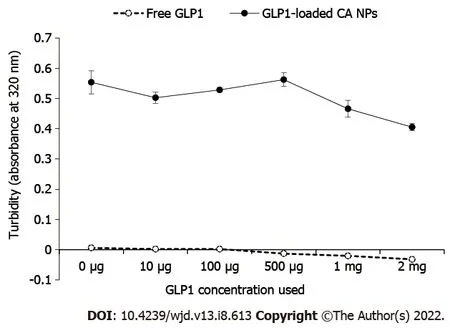
Size and elemental analysis
The slow progress or lack of interest in developing particles that encapsulate native GLP1 could be attributed to the rapid metabolism of GLP1, and as such, making GLP1-RAs a potentially more viable option. The only NPs preparation for intravenous GLP1 administration, a study design closest to the present study, was reported more than a decade ago[14]. The preparation, which used liposome as the drug carrier, produced a 3.6-fold higher serum GLP1 Level than that of free GLP1 at 15 min posttreatment. But the elevated GLP1 Level decreased rapidly thereafter. Another preparation, which was comparable to the present study in terms of the administrative dose and test subject, and involved a
If thou hadst been at the ball, said one of her sisters, thou wouldst not have been tired with it. There came thither the finest princess, the most beautiful ever was seen with mortal eyes; she showed us a thousand civilities, and gave us oranges and citrons.

Binding affinity of GLP1 towards CA NPs
In SDS-PAGE, a GLP1 band along with a FBS band was observed for CA NPs prepared with 1 mg and 2 mg GLP1. A more prominent GLP1 band was seen from the latter (Figure 3). Results confirmed that there was sufficiently stable complex formation between the NPs and GLP1. Serum proteins did not trigger the dissociation of GLP1 from the CA NPs.
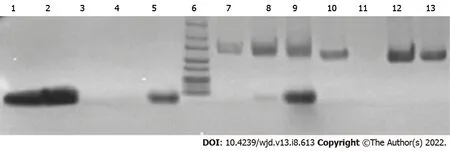
Effect of GLP1-CA NPs on the viability of human cell line
A stable GLP1-CA NPs was successfully fabricated. The NPs improved the systemic half-life of GLP1 as compared with free GLP1-treated rats. The increased plasma GLP1 Level was maintained for at least 4 h post-treatment.
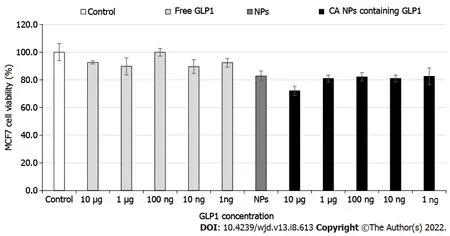
Plasma half-life of GLP1
The plasma levels of GLP1 in rats treated with GLP1-CA NPs were significantly higher than control rats at 1 h (49.61 ± 9.24 picomolar (pM),
< 0.05), 2 h (20.22 ± 5.20 pM,
< 0.05), and 4 h (16.32 ± 4.01 pM,
< 0.05) (Figure 5). The increased plasma GLP1 Level at 1 h in GLP1-CA NPs treated rats was also significantly higher than the levels measured from rats administered with free GLP1 (15.68 ± 4.34 pM,
< 0.05).
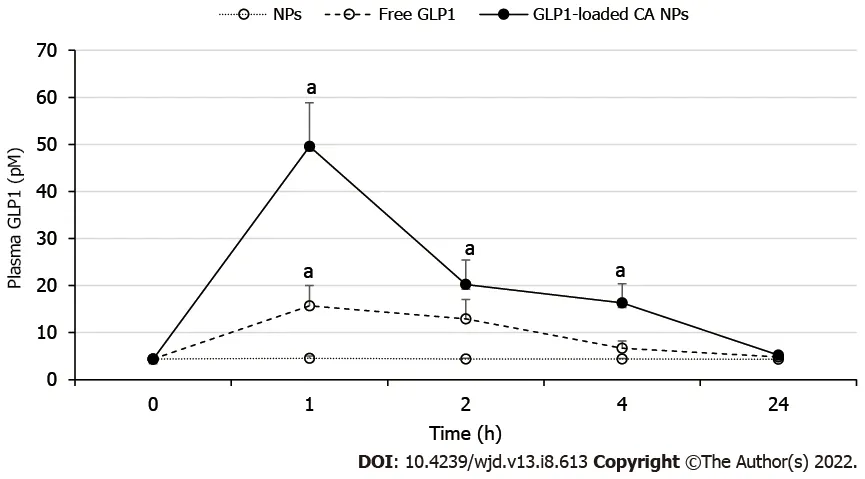
DlSCUSSlON
Therapeutic drug with a high tendency of reaching its target site may have increased efficiency and limited side effects. Nanosize particle has the advantage in this aspect as it allows targeted drug delivery. In the present study, a new GLP1-loaded nanosize particle with controlled release property was successfully developed. The formulation adds to the list of GLP1 nanoparticles reported to date,which has made little progress since our review of clinically available GLP1 NPs for diabetic treatment 5 years ago[13].
As shown in Figure 2A, CA NPs was approximate 200 nm in sizes. The presence of GLP1 (1 and 10 μg)along with 4 mmol/L CaCl
yielded particles of heterogeneous sizes. Accordingly, 1 μg GLP1 gave rise to particle sizes ranging from approximate 15 to 200 nm (Figure 2B), while 10 μg GLP1 produced particles with intermediate sizes ranging from approximate 60 to 70 nm (Figure 2C). Energy Dispersive X-Ray Analysis-based elemental analysis showed that particles formed with 10 μg GLP1 contained more carbon than particles formed with 1 μg GLP1, which may be explained by the presence of higher amount of hydrocarbon in the particles formed with 10 μg GLP1. In addition, the calcium/phosphate(Ca
/P) ratio was found to be much higher in particles fabricated with higher amount of GLP1,probably as a result of phase transformation (data not shown).
silica-based pH sensitive nanomatrix system, showed a burst release of GLP1 during the first hour. The plasma level of GLP1 however, returned to basal level at 4 h[15].
The GLP1-CA NPs have improved the systemic bioavailability of GLP1, showing better sustained release properties than the liposomal carrier and pH sensitive nanomatrix system. The plasma GLP1 Level of the CA NPs-treated rats was 3.2-fold higher compared to the free GLP1-treated rats at 1 h, and the level was sustained for at least 4 h post-treatment. Although carbonate apatite was reported to have strong affinity toward bovine serum albumin at physiological pH[16], the observed high binding affinity of GLP1 towards CA NPs may have negated the potential interaction between CA NPs and various blood proteins.
The liposomal preparation[14], and the silica-based pH sensitive nanomatrix system[15] mentioned above reported significant reduction in the glucose level, and the liposomal GLP1 also significantly increased insulin secretion. Given that CA NPs showed superior plasma GLP1 profile to these preparations, it is reasonable to predict that GLP1-loaded CA NPs will exert similar insulinotropic and hypoglycaemic effects. Nonetheless, further studies are necessary to confirm the therapeutic effects of GLP1-CA NPs.
Despite having a short plasma half-life, GLP1 may still be preferred to GLP1 agonists for therapeutic use. This is evidenced in several studies which used nanomaterials without GLP1 or GLP1-RAs as payload to stimulate GLP1 secretion[5,17,18]. The surface-modified lipid-based nanocarriers not only increased GLP1 secretion significantly, but normalised plasma glucose levels, and reduced insulin resistance in obese/diabetic mice following a 4 wk treatment[5].
Liraglutide, exenatide and exendin-4 are GLP1-RAs widely used to improve the therapeutic effects of GLP1. It is therefore useful to understand the pharmacokinetic/pharmacodynamic profiles of GLP1-RAloaded carrier systems so as to gain a better understanding of how significant these preparations had in improving GLP1 bioavailability when comparing with GLP1 nanoparticles, and this was reviewed recently[19]. In order to make comparison between GLP1-CA NPs and GLP1-RAs preparations for their systemic bioavailability and usefulness, only studies that used rats as test subjects and preparations meant for oral administration were discussed below.
A poor man and his wife lived in a little cottage, where they supported themselves by catching1 fish in the nearest river, and got on as best they could, living from hand to mouth
Exendin-4 released from enteric-coated capsule containing pH responsive NPs showed a maximum plasma concentration at 5 h after treatment[20]. Another preparation that involved poly(lactic-coglycolic acid) NPs conjugated with dextran and a C-terminal Src kinase peptide showed peak plasma exenatide level at 6 h post-administration. However, the elevated plasma exenatide level was not significantly different from rats receiving subcutaneous injection of exenatide solution, which was used as a positive control[21]. Zhang
[22,23] who used functionalised NPs for oral exenatide delivery,reported maximum plasma exenatide level at 4 h and 6 h, respectively after administration. But similar to the study by Song
[21], the exenatide level was not significantly different from that seen in rats administered subcutaneously with an exenatide solution. Overall, the sustainability of the plasma concentration of GLP1-RAs encapsulated in various types of nanomaterials was between 4-6 h, only slightly higher than that of GLP1-encapsulated CA NPs, although an oral formulation may produce better patient compliance than parenteral administration.
On the other side, she was sad, she couldn t understand how come after all these years, he still doesn t understand her at all, she loves him a lot, but she just can t take it any- more. Phone s ringing, she refuses to answer knowing that it s him. What s the point of talking now that it s over. I have asked for it and now. I want to keep it this way, if not I will lose face. She thought. Phone still ringing. She has decided10 to pull out the cord11.
Prince Featherhead was almost equally puzzled, for he had heard nothing from the King and Queen but the praises of this charming Princess, and the fact that they had spoken of her as so very beautiful only confirmed his opinion that people who live in the country have no taste
My sledge! Don t forget my sledge! He thought of that first, and it was fastened to one of the great white birds who flew behind with the sledge on its back
Liraglutide and semaglutide have been approved by the United States Food and Drug Administration as weight management agents, and semaglutide in obese or overweight adults with at least one weight-related condition including diabetes. Emerging evidences support the implementation of pharmacotherapy along with behavioural therapy and dietary intervention in optimising obesity treatment. The same approach may apply to diabetes management because consumption of food with antioxidant and anti-inflammatory properties could synergise the effects of GLP1 and GLP1-RAs[24]. If combination therapy is the recommendation for the treatment of metabolic syndrome, the overall cost of management should be taken into consideration.
This study was limited by the lack of chronic and sub-chronic
study involving obese or diabetic animals. A longer duration of study and measurement of metabolic parameters will provide evidence of the effectiveness of GLP1 CA NPs in the long-term treatment of metabolic syndrome.Nevertheless, we showed that this new preparation has therapeutic potential. A second limitation is on the discussion of the data itself. In order to make valid and comparable comparison of the pharmacokinetics profiles between the different GLP1 nanocarriers, only studies that used the same animal species, and native GLP1 were included in the discussion. This means that not all GLP1 and GLP1 RAs nanocarriers that are reported to date have been included. The literature search has nevertheless implied that there is higher interest in GLP1-RAs than native GLP1 despite the high cost of producing GLP1-RAs.
CONCLUSlON
In summary, we have developed a new nanocarrier for GLP1.
, the GLP1-CA NPs are safe on human cell lines, and stable against dissociation from interaction with plasma proteins.
, GLP1-CA NPs demonstrated sustained release properties by significantly improving the plasma half-life of GLP1. The preparation has resulted in a better GLP1 systemic bioavailability than previously reported GLP1-loaded nanocarriers, making it a potentially promising treatment option for metabolic syndrome.
ARTlCLE HlGHLlGHTS
Research background
He said, The room is too small and can hardly accommodate all of our things. So we could only hang them on the walls. The landlord did not listen to him and turned around up to the floor.
Research motivation
The GLP1-carbonate apatite nanoparticles (CA NPs) overcome the short half-life of GLP1. The nanoparticles could be a potential therapeutic option for metabolic syndrome and warrant further investigation.
Research results
In the MTT assay, both the free GLP1 and CA NPs-bound GLP1 did not exert noticeable effects on the viability of the human cell line (Figure 4). This suggests that the GLP1-loaded CA NPs are likely to be safe for clinical application. More pre-clinical studies are needed to confirm this.
37. Rumpelstiltskin: While most scholars believe that Rumpelstiltskin is simply a nonsense name, others have proposed explanations for the name s meaning and/or origins. I have included some of the theories here.
Research methods
The nanoparticles were fabricated through complexation between GLP1 and CA NPs. The GLP1-CA NPs was then evaluated for physicochemical properties, tested for their potential cytotoxic effects on human cell line, and finally measured for systemic bioavailability in rats through intravenous administration.
Research objectives
To fabricate GLP1-loaded carbonate apatite nanoparticles (GLP1-CA NPs), and improve the systemic half-life of GLP1 through GLP1-CA NPs.
Research conclusions
pH sensitive inorganic carbonate apatite nanoparticles, which we have successfully formulated previously may be a potential carrier for GLP1.
Research perspectives
GLP1 is an endogenous peptide with established glucose lowering property. Its therapeutic use however is limited due to it being rapidly degraded in the systemic circulation. Nanosize particles with sustained release property may protect as well as extend the plasma half-life of GLP1.
ACKNOWLEDGEMENTS
The man slept well and soundly, for he had run about a great deal during the day; but the woman could not fall asleep at all, and flung herself from one side to the other the whole night through, thinking always what more was left for her to be, but unable to call to mind anything else
FOOTNOTES
Lee CY and Chowdhury E contributed to the study concept and design; Ibnat N, Zaman R and Uddin B acquired the data; Ibnat N, Uddin B, Lee CY and Chowdhury E analysed the data; Ibnat N drafted the manuscript; Lee CY reviewed and edited the manuscript; all authors have read and approved the final manuscript.
an FRGS grant from the Ministry of Education, Malaysia, No. FRGS/2/2014/SG05/MUSM/03/1.
The study was reviewed and approved by the Monash University Animal Ethics Committee (Approval No. MARP/2016/008).
There is no conflict-of-interest.
No additional data are available.
The authors have read the ARRIVE guidelines, and the manuscript was prepared and revised according to the ARRIVE guidelines.
This article is an open-access article that was selected by an in-house editor and fully peer-reviewed by external reviewers. It is distributed in accordance with the Creative Commons Attribution NonCommercial (CC BYNC 4.0) license, which permits others to distribute, remix, adapt, build upon this work non-commercially, and license their derivative works on different terms, provided the original work is properly cited and the use is noncommercial. See: https://creativecommons.org/Licenses/by-nc/4.0/
Malaysia
Nabilah Ibnat 0000-0002-7018-4867; Rahela Zaman 0000-0002-8249-7668; Mohammad Borhan Uddin 0000-0003-4384-4900; Ezharul Chowdhury 0000-0002-5705-841X; Chooi Yeng Lee 0000-0001-5847-0329.
Wu YXJ
So they did this; but the more they put in the more room there seemed to be, and at last they put back all the jewels and dresses they had taken out, and Beauty even added as many more of the jewels as she could carry at once; and then the trunks were not too full, but they were so heavy that an elephant could not have carried them! The Beast was mocking us, cried the merchant; he must have pretended to give us all these things, knowing that I could not carry them away
Many psychologists, including Bruno Bettelheim, consider this tale to be about children s fear of abandonment and their oral greed. Children have a fear of abandonment by their parents. They are also orally greedy and fear starvation from their parents if they are overly greedy. The tale supposedly helps them come to term with these fears. Many psychologists have not considered the opposite themes of parental61 abuse and poverty until recently. One of the earliest articles on the topic is:
Filipodia
Wu YXJ
1 Chatterjee S, Ghosal S, Chatterjee S. Glucagon-like peptide-1 receptor agonists favorably address all components of metabolic syndrome.
2016; 7: 441-448 [PMID: 27795818 DOI: 10.4239/wjd.v7.i18.441]
2 Prasad-Reddy L, Isaacs D. A clinical review of GLP-1 receptor agonists: efficacy and safety in diabetes and beyond.
2015; 4: 212283 [PMID: 26213556 DOI: 10.7573/dic.212283]
3 Patel A, Cholkar K, Mitra AK. Recent developments in protein and peptide parenteral delivery approaches.
2014; 5: 337-365 [PMID: 24592957 DOI: 10.4155/tde.14.5]
4 van Witteloostuijn SB, Pedersen SL, Jensen KJ. Half-Life Extension of Biopharmaceuticals using Chemical Methods:Alternatives to PEGylation.
2016; 11: 2474-2495 [PMID: 27775236 DOI: 10.1002/cmdc.201600374]
5 Xu Y, De Keersmaecker H, Braeckmans K, De Smedt S, Cani PD, Préat V, Beloqui A. Targeted nanoparticles towards increased L cell stimulation as a strategy to improve oral peptide delivery in incretin-based diabetes treatment.
2020; 255: 120209 [PMID: 32580098 DOI: 10.1016/j.biomaterials.2020.120209]
6 Bech EM, Pedersen SL, Jensen KJ. Chemical Strategies for Half-Life Extension of Biopharmaceuticals: Lipidation and Its Alternatives.
2018; 9: 577-580 [PMID: 30034579 DOI: 10.1021/acsmedchemlett.8b00226]
7 Park J, Bak M, Min K, Kim HW, Cho JH, Tae G, Kwon I. Effect of C-terminus Conjugation
Different Conjugation Chemistries on In Vivo Activity of Albumin-Conjugated Recombinant GLP-1.
2021; 13 [PMID: 33672039 DOI: 10.3390/pharmaceutics13020263]
8 Patil S, Vhora I, Amrutiya J, Lalani R, Misra A. Role of Nanotechnology in Delivery of Protein and Peptide Drugs.
2015; 21: 4155-4173 [PMID: 26323432 DOI: 10.2174/1381612821666150901095722]
9 Lee PW, Pokorski JK. Poly(lactic-co-glycolic acid) devices: Production and applications for sustained protein delivery.
2018; 10: e1516 [DOI: 10.1002/wnan.1516]
10 Raza F, Zafar H, Zhu Y, Ren Y, -Ullah A, Khan AU, He X, Han H, Aquib M, Boakye-Yiadom KO, Ge L. A Review on Recent Advances in Stabilizing Peptides/Proteins upon Fabrication in Hydrogels from Biodegradable Polymers.
2018; 10 [PMID: 29346275 DOI: 10.3390/pharmaceutics10010016]
11 Chowdhury EH, Maruyama A, Kano A, Nagaoka M, Kotaka M, Hirose S, Kunou M, Akaike T. pH-sensing nano-crystals of carbonate apatite: effects on intracellular delivery and release of DNA for efficient expression into mammalian cells.
2006; 376: 87-94 [PMID: 16723196 DOI: 10.1016/j.gene.2006.02.028]
12 Kim TK. T test as a parametric statistic.
2015; 68: 540-546 [PMID: 26634076 DOI:10.4097/kjae.2015.68.6.540]
13 Lee CY. Glucagon-Like Peptide-1 Formulation--the Present and Future Development in Diabetes Treatment.
2016; 118: 173-180 [PMID: 26551045 DOI: 10.1111/bcpt.12524]
14 Hanato J, Kuriyama K, Mizumoto T, Debari K, Hatanaka J, Onoue S, Yamada S. Liposomal formulations of glucagon-like peptide-1: improved bioavailability and anti-diabetic effect.
2009; 382: 111-116 [PMID: 19698772 DOI:10.1016/j.ijpharm.2009.08.013]
15 Qu W, Li Y, Hovgaard L, Li S, Dai W, Wang J, Zhang X, Zhang Q. A silica-based pH-sensitive nanomatrix system improves the oral absorption and efficacy of incretin hormone glucagon-like peptide-1.
2012; 7: 4983-4994 [PMID: 23028226 DOI: 10.2147/IJN.S30013]
16 Hossain S, Stanislaus A, Chua MJ, Tada S, Tagawa Y, Chowdhury EH, Akaike T. Carbonate apatite-facilitated intracellularly delivered siRNA for efficient knockdown of functional genes.
2010; 147: 101-108 [PMID:20620182 DOI: 10.1016/j.jconrel.2010.06.024]
17 Beloqui A, Alhouayek M, Carradori D, Vanvarenberg K, Muccioli GG, Cani PD, Préat V. A Mechanistic Study on Nanoparticle-Mediated Glucagon-Like Peptide-1 (GLP-1) Secretion from Enteroendocrine L Cells.
2016; 13:4222-4230 [PMID: 27934480 DOI: 10.1021/acs.molpharmaceut.6b00871]
18 Xu Y, Carradori D, Alhouayek M, Muccioli GG, Cani PD, Préat V, Beloqui A. Size Effect on Lipid Nanocapsule-Mediated GLP-1 Secretion from Enteroendocrine L Cells.
2018; 15: 108-115 [PMID: 29226685 DOI:10.1021/acs.molpharmaceut.7b00742]
19 Eissa NG, Elsabahy M, Allam A. Engineering of smart nanoconstructs for delivery of glucagon-like peptide-1 analogs.
2021; 597: 120317 [PMID: 33540005 DOI: 10.1016/j.ijpharm.2021.120317]
20 Nguyen HN, Wey SP, Juang JH, Sonaje K, Ho YC, Chuang EY, Hsu CW, Yen TC, Lin KJ, Sung HW. The glucoselowering potential of exendin-4 orally delivered
a pH-sensitive nanoparticle vehicle and effects on subsequent insulin secretion in vivo.
2011; 32: 2673-2682 [PMID: 21256586 DOI: 10.1016/j.biomaterials.2010.12.044]
21 Song Y, Shi Y, Zhang L, Hu H, Zhang C, Yin M, Chu L, Yan X, Zhao M, Zhang X, Mu H, Sun K. Synthesis of CSKDEX-PLGA Nanoparticles for the Oral Delivery of Exenatide to Improve Its Mucus Penetration and Intestinal Absorption.
2019; 16: 518-532 [PMID: 30601014 DOI: 10.1021/acs.molpharmaceut.8b00809]
22 Zhang L, Shi Y, Song Y, Duan D, Zhang X, Sun K, Li Y. Tf ligand-receptor-mediated exenatide-Zn
complex oraldelivery system for penetration enhancement of exenatide.
2018; 26: 931-940 [PMID: 29619854 DOI:10.1080/1061186X.2018.1455839]
23 Zhang L, Shi Y, Song Y, Sun X, Zhang X, Sun K, Li Y. The use of low molecular weight protamine to enhance oral absorption of exenatide.
2018; 547: 265-273 [PMID: 29800739 DOI: 10.1016/j.ijpharm.2018.05.055]
24 Lee CY. A Combination of Glucagon-Like Peptide-1 Receptor Agonist and Dietary Intervention Could Be a Promising Approach for Obesity Treatment.
2021; 12: 748477 [PMID: 34616367 DOI:10.3389/fendo.2021.748477]
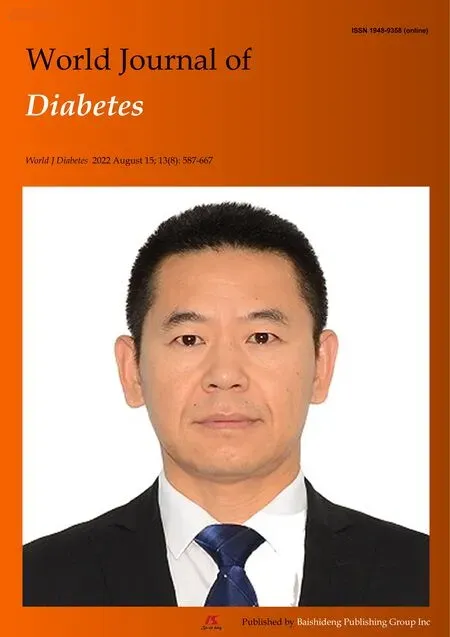 World Journal of Diabetes2022年8期
World Journal of Diabetes2022年8期
- World Journal of Diabetes的其它文章
- Loss of skeletal muscle mass is not specific to type 2 diabetes
- Association of rs1137101 with hypertension and type 2 diabetes mellitus of Mongolian and Han Chinese
- Metformin toxicity: A meta-summary of case reports
- In vivo evaluation and mechanism prediction of anti-diabetic foot ulcer based on component analysis of Ruyi Jinhuang powder
- Clopidogrel delays and can reverse diabetic nephropathy pathogenesis in type 2 diabetic db/db mice
- Diabetic kidney disease in pediatric patients: A current review
